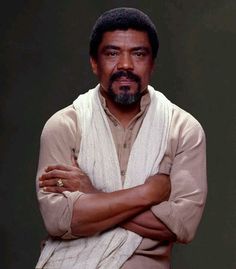
Alvin Ailey rose from a childhood of extreme poverty in the segregated world of small-town Texas to become a leading figure in the establishment of modern dance as a popular art form in America. As a choreographer, dancer and director, Mr. Ailey also played an important role in establishing black modern dance. He became a noted Broadway dancer and, starting in the late 1950’s, a choreographer of work that explored a wide range of the black experience.
The troupe he founded in 1958, the Alvin Ailey American Dance Theater, became the most popular dance company on the international touring circuit. At home and abroad, the company was known for its vibrant artistry and repertory, and for Mr. Ailey’s motivating humanist vision.
Mr. Ailey saw his troupe as fulfilling the need for a repertory company that would perform modern-dance classics along with his own works. To that end he presented signature pieces, otherwise infrequently performed, by such pioneers as Katherine Dunham, Pearl Primus and Ted Shawn. The company served as a repository for contemporary modern dance by black choreographers like Talley Beatty, Donald McKayle and George Faison. And Mr. Ailey invited younger modernists, including Bill T. Jones and Arnie Zane, Elisa Monte and Ulysses Dove, to create dances for the company.
Mr. Ailey’s own dances, however, form the core of the company’s repertory. They range from work drawn from his memories of the black churches and honky-tonk bars he knew as a child to searing social protest dances like his 1969 ”Masekela Langage” (a piece about being black in South Africa), to spirited, stylish celebrations of the music of Duke Ellington (”Night Creature,” 1974).
Alvin Ailey was born on Jan. 5, 1931, in Rogers, Tex., a small town 50 miles south of Waco. His mother, Lula, was 17 when he was born; she was abandoned by her husband six months later. There was a deep attachment between Mr. Ailey and his mother, who earned their livelihood by picking cotton and doing laundry and domestic work. Later she worked in an aircraft factory in Los Angeles.Mr. Ailey came into contact with dance gradually in Los Angeles, where he and his mother moved when he was 12. An athletic student with a gift for foreign languages, Mr. Ailey did backyard imitations of Gene Kelly, but did not see a live dance performance until a junior high school class trip to a performance by the Ballet Russe de Monte Carlo. Though disappointed that ”Scheherazade” seemed so tame, he began to haunt the city’s theater section. ”I first saw the Dunham company there,” he recalled years later. ”I went over one day and there were pictures of black dancers.”
Mr. Ailey created his first three dances for the company. But in 1954 he and Carmen de Lavallade, also a Horton dancer, were invited to perform on Broadway as featured dancers in Truman Capote’s ”House of Flowers.” The musical ran for only four months, but Mr. Ailey settled in New York to study modern dance with Martha Graham, Hanya Holm and Charles Weidman, ballet with Karel Shook and acting with Stella Adler and Milton Katselas.He went on to appear in the 1954 film ”Carmen Jones,” acted in the 1955 Off Broadway production ”The Carefree Tree,” and returned to Broadway in 1957 in the musical ”Jamaica.” He directed the revue ”African Holiday” in 1960 and co-directed ”Jerico-Jim Crow,” a song-play by Langston Hughes, Off Broadway in 1964. There were other acting roles, in ”Call Me by My Rightful Name” in 1961 and on Broadway in ”Tiger, Tiger, Burning Bright” in 1962. His choreography over the next few years included dance for Samuel Barber’s opera ”Antony and Cleopatra,” which was the first Metropolitan Opera production at Lincoln Center, and for Leonard Bernstein’s ”Mass,” for the opening of the Kennedy Center for the Performing Arts in Washington. The Start of a Company
But it was an earlier concert, in March 1958 at the 92d Street Y in New York, that crystallized his future. In a performance shared with Ernest Parham, Mr. Ailey and six other dancers presented three works, including ”Blues Suite.” Three months later, John Martin, dance critic of The Times, singled out Mr. Ailey as one of the six outstanding artists that season. ”As a performer he has a rich, animal quality of movement and an innate sense of theatrical projection, which have been known before; but as a choreographer he had not previously shown his work here. It was an impressive debut.”
The concert was the start of Mr. Ailey’s company. Four years later the State Department sent the Ailey dancers to Australia and Southeast Asia on the first of many immensely successful foreign tours. Domestic successes were few, however, until a 1969 engagement on Broadway at the Billy Rose Theater.
A successful two-week season at the ANTA Theater in New York early in 1971 helped to establish the troupe as a major company. That year, Mr. Ailey founded the Alvin Ailey American Dance Center, the company’s bustling official school and the home of the Alvin Ailey Repertory Ensemble, a junior troupe. In 1972, the company joined the City Center of Music and Drama. The school and companies have just moved into new headquarters near Lincoln Center.
Today, the 28-member company has an annual season at City Center and a 35-week national and international touring season. It has performed in 45 countries on 6 continents. Mr. Ailey’s choreography, including commissioned premieres, has also been performed by the American Ballet Theater, the Joffrey Ballet, the Paris Opera Ballet, the London Festival Ballet, the Royal Danish Ballet and companies in Italy, Venezuela and Israel.
